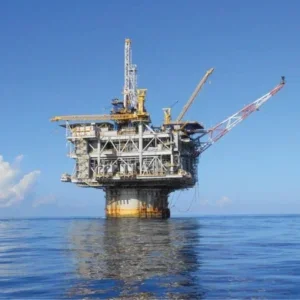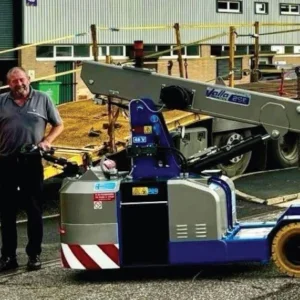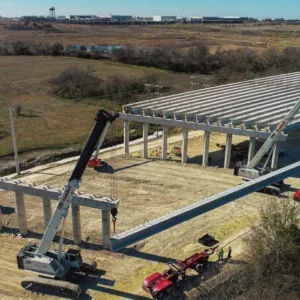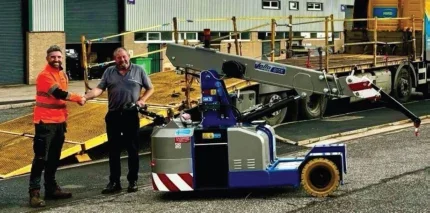
The definition is fairly simple: a crane that can pick up a load and carry it to somewhere else is essentially a pick and carry crane. Their scale can vary hugely: from tiny mini cranes (with lifting capacities of a tonne or two) to lattice or teleboom crawlers that can lift, perhaps in tandem in a tailing operation, an industrial refinery or distillation tower weighing several hundred tonnes.
A subset of the species is the carry-deck crane. Again, it does what it says on the tin. It has a deck on its front and puts the load onto the deck to carry it along. In Europe, at least, such carry-decks as there are seem to be smallcapacity machines, mini cranes or not much bigger. On the other side of the Atlantic they go bigger: the medium- and high-capacity carry-deck, it seems, are a North American speciality. Geographical preferences do not end there: Australia has long been a pioneer and manufacturer of the articulated pick and carry crane, with Franna (now part of Terex) and Tidd being major implementers of the theme.
Outriggers are not required, or indeed possible, for the ‘carry’ stage of a pick and carry – though they may be fitted and used for the lifting and lowering part. Some rough terrain and all terrain cranes can, and frequently do, perform pick and carry operations; but they are specialised enough to form quite separate categories of their own and we shall not deal with them here.
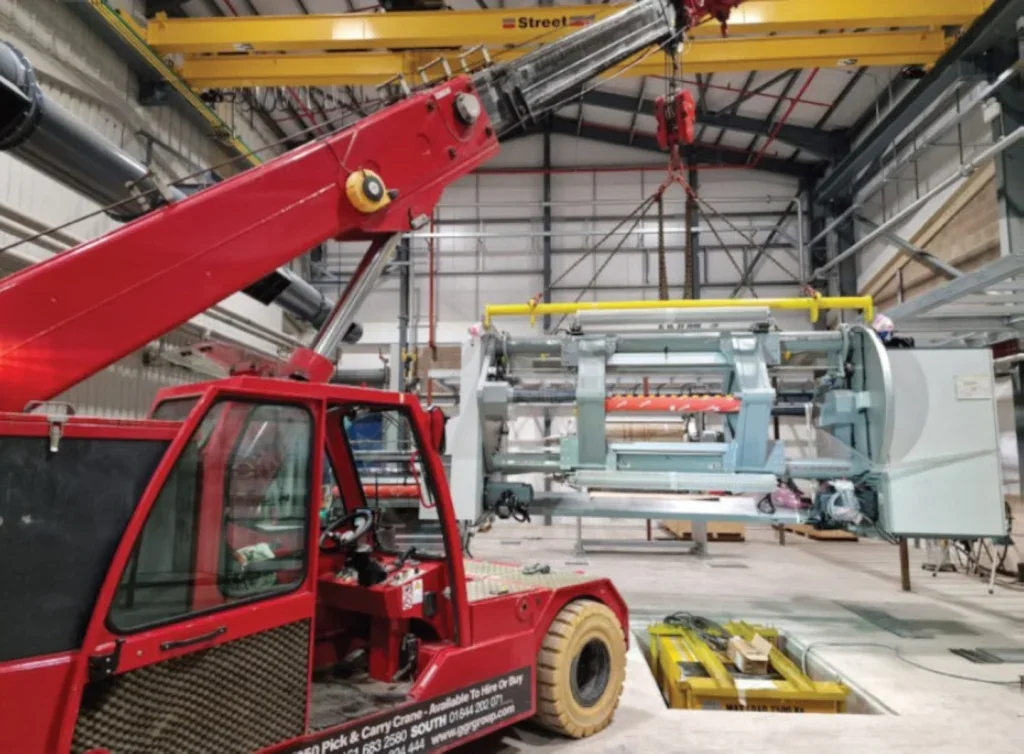
Now that we know what we are talking about we can look at some examples of machines and of applications. Starting at the smaller end, a typical application is repositioning equipment inside a factory or manufacturing plant; here electric power makes smaller pick and carries particularly suitable for indoor use.
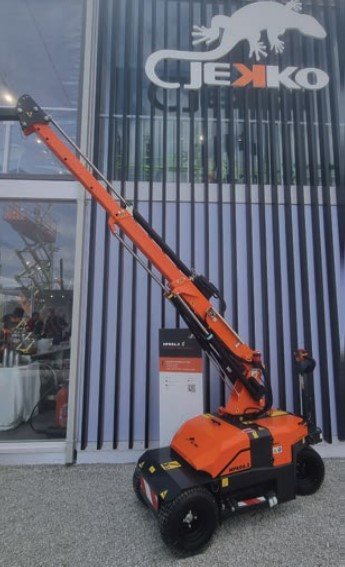
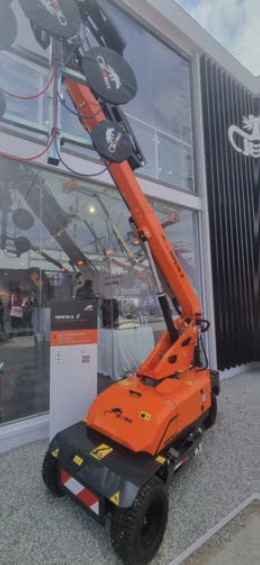
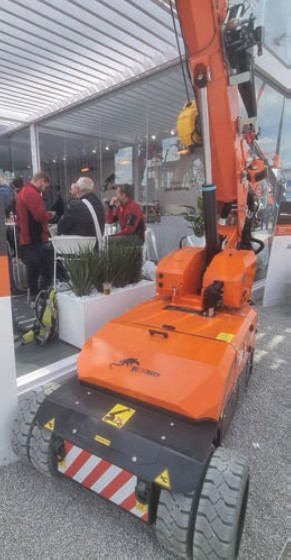
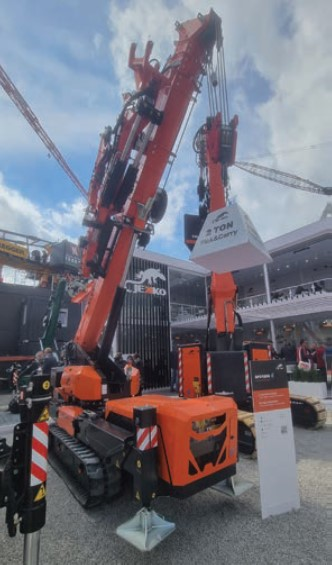
Thus earlier this year Lancashire, UK-headquartered mini crane specialist GGR Group assisted in a complex lifting project inside a manufacturing facility; it required precise positioning of heavy-duty equipment. For this it used its GF250 pick and carry crane made by Italian manufacturer Galizia.
The ride-on operated machine is a three-wheeler, mounted on nonmarking white-rubber tyres. It has maximum safe working load of 25 tonnes at 1.5m and is 470mm long by 2296mm wide. This means it can pass through larger entryways. It has hydraulic steering on the rear wheel and directional drive motors on the front axle which give it a tight turning circle (of 4190mm). This is an advantage for navigating around existing structures inside a factory. It is powered by a 96v rechargeable battery that delivers 30kW.
Pedestrian-controlled (i.e walk behind) small pick and carries are also available and are similarly useful in factory environments.
Hird, based in Hull, UK, is the authorised distributor for Valla. It recently sold a Valla 25E pick and carry crane to KC Machine Movers. The company, based in Sheffield, South Yorkshire, carries out machinery removal and installation projects in a wide range of sectors, including pharma, steel and forging and, increasingly, emerging industries like EV charging installation.
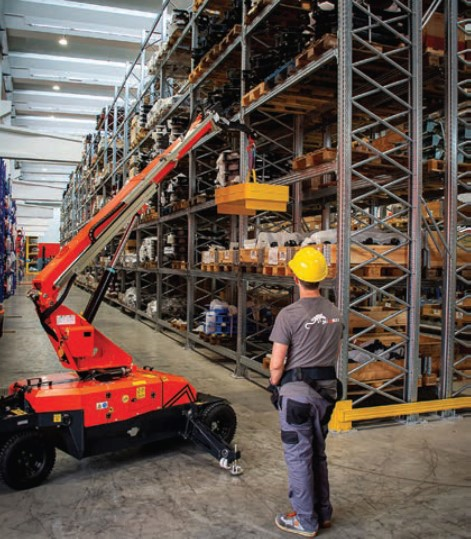
KC Machine Movers already operates a Valla 120E mini crane – a ride-on machine – which has a maximum safe working load of 12 tonnes. Its new walk-behind 25E has a SWL of 2.5 tonnes and is being used to support the dismantling and installation of smaller items of machinery.
It is extremely compact, at just 950mm wide and 2260mm long. It is battery-powered with a maximum boom height of 4.8m (SWL – 1000kg) and a maximum working radius of 2.7m (SWL – 500kg). Travel functions are controlled by a tiller arm; lifting is via a cabled remote-control unit. This allows the crane operator to stand in the optimum position to control the lift safely and productively. There is an optional manual fly jib to support lifting in confined places where overhead space is limited and extra reach is critical. The crane is fitted with non-marking superelastic tyres for both indoor and outdoor working.
As well as supporting machinery moving projects the Valla 25E will be used by KC Machine Moving’s engineering services teams, working on electrical and mechanical systems.
“It is the endless flexibility of the Valla mini crane in helping us simplifying lifts and carrying them out safely that we appreciated,” says KC director Kevin Hill. “It can be lifting pipes or EV charging units, or supporting machinery maintenance and whole factory moves.”
Valla is expanding in the sector. The company has invested in the development and production of four new heavy pick and carry cranes in its V-range.
The cranes are electric battery powered, with wireless remote control, and with options for safe working loads of 35tm 40t, 45t and 50t. They can be supplied with long and short booms, and with or without sit-in cabs. Available attachments include a winch, a manual stubby fly jib, a hydraulic luffing fly jib, and a self-levelling fork attachment.
DUAL FUNCTIONS
Many other mini cranes have pick and carry capabilities. Often these are incidental to their primary function as glazing robots or mini crawlers. For example, Jekko’s MPK06.2 and MPK10.2 are marketed as part of its mini-picker and glass robot range. But, to quote Jekko’s marketing material: ‘…in a few minutes they transform into a compact pick and carry crane’.
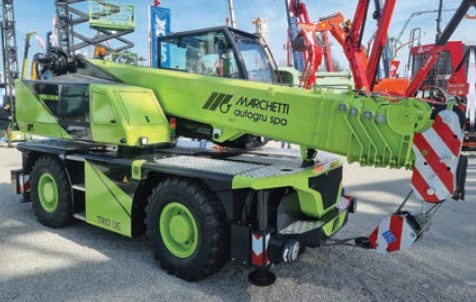
The machines have been redesigned and the new designs were launched at this year’s Bauma. They are battery operated, compact, fit a standard single door, and can be specified with white, non-marking tyres if required. The ballast is in easily removable modules to make it easier to transport, for example on elevators. They have a mobile turret designed to provide smooth, millimetre-precise positioning of the load.
The largest model in the family, the two tonne-capacity MPK20.2, also launched at Bauma, has undergone a more complete redesign and is the opposite of the previous models: instead of being a mini-picker that can become a pick and carry it is marketed as a pick and carry that can become a mini-picker. It is a two-tonne pick and carry crane that, with the installation of the independent glass manipulator JVM800, transforms into a glass robot.
It can work in hook or winch mode, has an intuitive control system with a five-inch IP66 onboard touchscreen display, radio remote control and tiller bar, and a new ‘steer by wire’ driving system that allows handling in the tightest spaces. The new Jekko machines can have, as an option, the J-Link Advanced Remote Monitoring System which allows real-time fleet management, machine optimisation, and predictive maintenance through advanced data analysis.
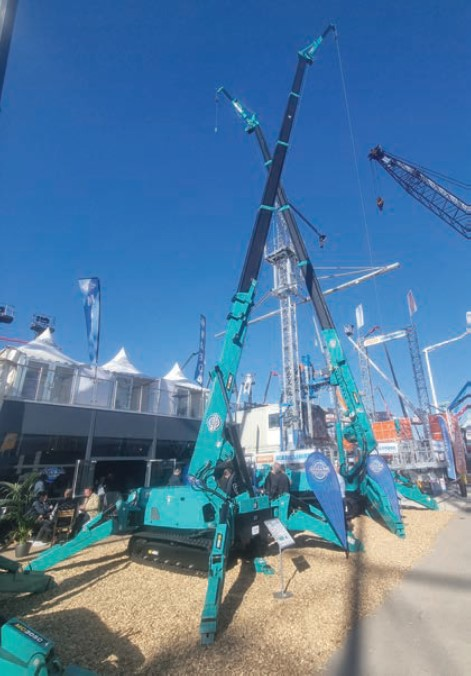
Also on Jekko’s stand at Bauma was its SPX1280, the largest in Jekko’s SPX mini crane range. The crane can be powered by diesel or electric battery pack. It has a maximum lifting capacity of eight tonnes and can operate in pick and carry mode with two tonnes on the hook. It offers 360° turret rotation and has extendable crawlers for improved driving.
BAUMA SHOWCASE
Other pick and carry cranes seen at Bauma 2025 included Marchetti Autogru’s new fully electric City Crane: the Trio 0e.
The crane has a lifting capacity of 15 tonnes and a total weight of 14 tonnes. The five-section telescopic boom extends from 5.2 to 19.1m. It can reaching a maximum height of 21m.
When in pick and carry mode it can carry 5.5 tonnes and travel at speeds of up to 5km/h. It is powered by two rechargable LifePO Lithium batteries The crane measures 6.1m long, 2m wide, and 2.9m high. The crane has a hydro-pneumatic suspension system and permanent 4×4 traction for enhanced stability and manoeuvrability. It has a maximum speed of 40km/h. Three steering modes are available (road, concentric and crab).
Mini crane manufacturer Maeda also showed a new crane at Bauma with pick and carry capabilities. It was the new MC405C-5 spider crane with a capacity of 3.83t × 2.7m, a maximum working radius of 16m × 0.21t, and a maximum lifting height of 16.8m. It can travel with 500kg on the hook.
Italian pick and carry crane specialist JMG Cranes had a selection of pick and carry cranes on its Bauma stand including the new JMG-MC100.08 which was displayed without a boom. This was because it has an interchangeable boom; users can fit a 15-tonne capacity long boom or a short boom. This interchangeable boom concept is also adopted on JMG’s new five-tonne capacity MC15.08 (not shown at Bauma). The JMG MC100.08 had been bought by German lifting and transport specialist Maltan and a video of it on its first job can be seen here: https://shorturl.at/1cgQE
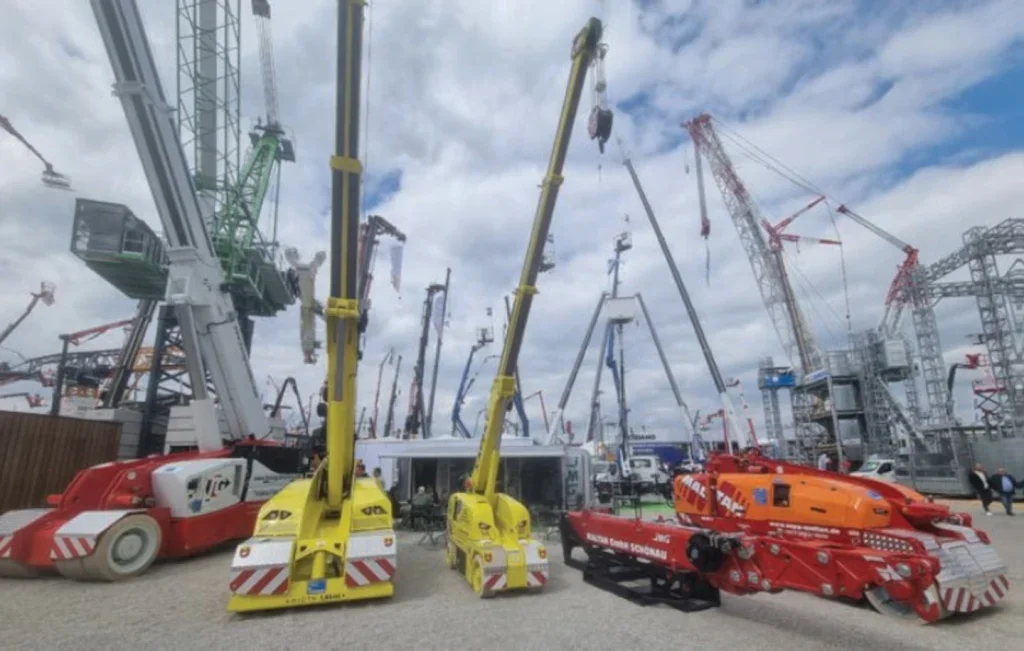
There was also the JMG MC650S, with a maximum lifting capacity of 65,000kg which had been bought by Transgranollers Gruas Y Transportes Especiales. And the 13,000kg capacity JMGMC130S and 4,500kg capacity radio controlled JMG-MC45SB – both of which had been bought by Groupe Lafont.
DOWN UNDER
Heading to Australia, we come to Tidd and Franna (which is now part of Terex) who are big names in pick and carry here.
Franna is headquartered in Brisbane. For several years it has been engaged in expanding its scope, both geographically and in terms of its product range.
Asia is a particular focus. Franna has had its own manufacturing plant in Hosur, India, since 2021. It has recently expanded it, adding a new dedicated 3,500 square metre assembly hall to manufacture its first model designed specifically for the Asian market. The 17-tonne capacity FR17 four-wheel drive compact is designed by a team of Indian and Australian engineers to be a cost-effective machine pitched as an entry-level crane for construction, industrial and yard applications where space is limited. It has a turning radius of 6.77m, a three-section 14.2m boom with a manually-extended fourth section to 18.23m, and a short extension that takes the maximum tip height to 20.8m. Safety technology includes antitipping, overload protection, and a monitoring system with Franna’s Dynamic LMI – for which, see below, and the box.
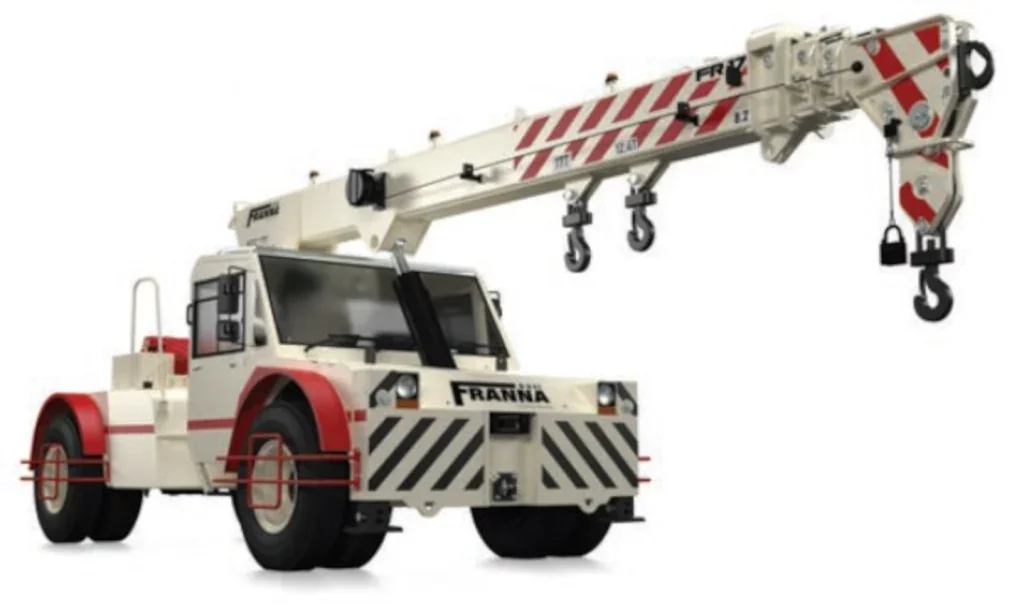
Franna is also marketing an international version of the crane, the FR17 C, in Africa, South America and the UAE. “Our success in India has provided us with a scalable model for sustainable growth,” said Jaideep Shekhar, vice president & managing director, Terex Materials Processing. “We’re also putting these learnings into practice in the Southeast Asia market, which has similar infrastructure demands and customer profiles.” To which end, in May, Franna appointed Aidan O’Neill to the new role of regional sales manager for Southeast Asia. He will be based in Malaysia.
Franna also has eyes on North America. In March this year it launched a new model aimed at that market. Again it is a 17-tonne crane, which works out at 19 US tons. The FR19 US joins the 20 tonne/24 ton AT24 US model, which was introduced in 2023 and, like its older brother, is an articulated model.
The FR19 US can handle its maximum capacity at 1.5m from the centre of the front wheels. It has an 18.2m four-section boom with a 2.6m jib attachment that takes the maximum tip height to 22.5m. Maximum forward reach on the main boom is 16.35m. The forward reach with jib installed is 18.6m.
The crane is powered by a 121hp Tier 4F Cummins diesel engine, driving a four speed powershift transmission. The front is rigid mounted to give a maximum road speed of 35kph/22 mph.
Overall chassis length is 6.13m and length from rear bumper to boom tip is 9.7m, with an overall width of 2.45m. Overall height is just under three metres.
This compact size and articulated steering system allow navigation through tight spaces and the precise manoeuvring and placement of loads. A high seated position and single lift cylinder gives the operator good visibility, improving safety and precision when lifting loads.
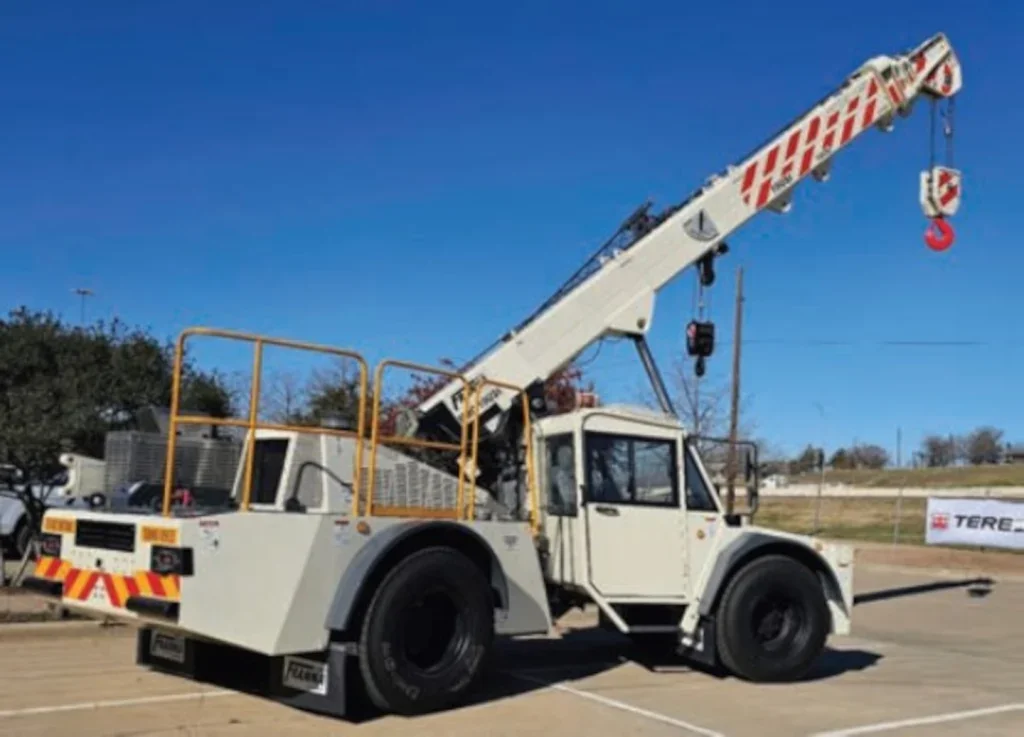
Franna cranes are fitted with its own patented DLMI (Dynamic Load Moment Indicator) system.
A further addition to the range, the AT44 US, is due to be launched later this year. Demonstrations are planned at the upcoming Utility Expo, from October 7–9, in Kentucky.
Franna has also appointed Mobile Cranes Canada (MCC) as an official distributor of Franna cranes across Canada. Based in Nisku, Alberta, MCC will represent Franna in Alberta, British Columbia, Saskatchewan, Manitoba, Ontario, New Brunswick, Nova Scotia, and Prince Edward Island. This marks a significant step forward for Franna as it expands its global footprint.
As part of the Canadian launch MCC has acquired an AT24 US model. The AT24 US made its Canadian debut at Alberta Heavy Equipment Show, which took place April 24-25, at the Edmonton EXPO Centre.
Tidd, manufacturing in Queensland, Australia, also favours the articulated pick and carry. Its latest model is the PC28-3G.
It is powered by the Euro 6 Cummins ISB6.7 engine, claimed as the highest emission-control diesel available with up to 90% less emissions. The crane has a lifting capacity of 28 tonnes, a four-section boom extending to 18.65 metres, and articulates 44 degrees either side of the centreline which, Tidd says, makes it the most manoeuvrable pick and carry on the market. It is only 2.5m wide and it can road its own 2.3t counterweight. An optional 1.1t Superlift counterweight is also available, fitted with Tidd’s ‘Safe Slew’ safety system.
This, like Franna’s DLMI, is because there used to be an inherent problem with articulating cranes. Back in the pre-digital days an operator could pick up a load over the front of an articulated crane and then drive it on sloping ground around a corner – at which point geometry could start playing nasty tricks.
Articulation combined with side slope and a load dramatically affects the position of the centre of gravity and hence the stability of the machine. Many operators inadvertently moved into the ‘red zone’ – that is, outside the 100% load chart – by cornering on a slope with too great a load on the hook. It was a serious issue for the construction industry and resulted in several rollovers annually.
Tidd’s Safe Slew system, and Franna’s DLMI, warn the operator, and restricts the steering if they approach a situation that triggers such an overload, making this an issue that now belongs firmly to the past.
Returning to the northern hemisphere, and to Europe, Befard is a perhaps less familiar name in small cranes. It is a Polish company; its main products are mini crawler cranes, glass lifters, glass vacuum lifters, and loader cranes. Its pick and carry minicrane range includes the XM 800, which has 900kg capacity and is small enough to fit inside a transit van for transport, and the XM 1200. Both are remote controlled and on crawler chassis.
The tracks of the XM 1200 are extendable, up to 1.25m for stability in lifting and for travel over rough ground, and are nonmarking for use indoors. When retracted the track width is 0.8m, which lets it fits through standard single doorways. Reach is over 7.5m, extendable with optional equipment to over 10m – which, as Befard points out, allows work at the height of a second floor. It can travel with 1200kg on the hook; when equipped with outriggers its maximum lifting capacity increases to 1500kg. Optional equipment includes a hydraulic winch.
Interestingly, the crane has three independent power sources – a 7.5kW combustion engine, a 1.5kW plug-in electric motor (230 V / 400 V / 110 V), and lithium-ion batteries that deliver 8Ah. With a properly configured machine the operator can freely choose between them, depending on the location and nature of the work.
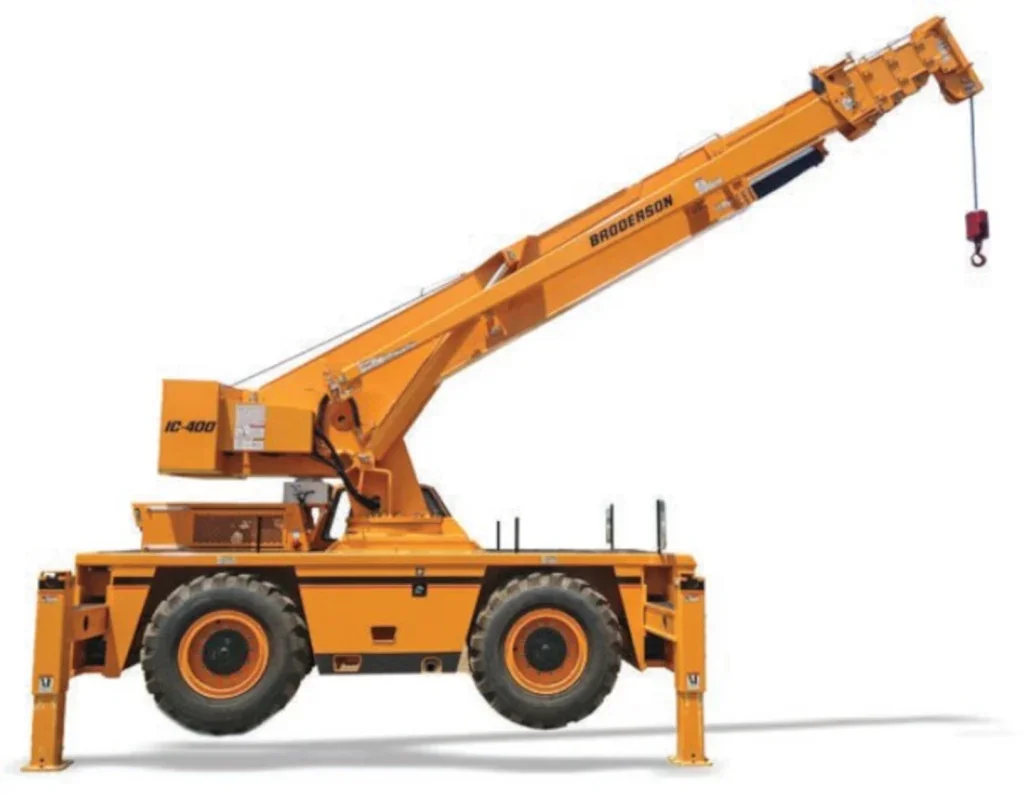
The front of the machine is configured as a loading deck, and there is a removable extension available for it which extends it by approximately 0.5 metres. The XM 800 has one also. In other words, although Befard does not use the expression, these are in effect carry-deck cranes.
That would seem to make them almost the only examples of carrydecks that are made in Europe – the other examples being from Valla, who offer the design with its SE series, with capacities from 10t to 22t. Carry-decks, though, are standard in North America but little known elsewhere.
It’s strange because as a concept the carry-deck would seem to have a lot to recommend it. The name says it all. It has a carrying deck on the front end, over the wheels, while the crane is mounted over the back wheels. The crane lifts the load, deposits on the deck, drives to its unloading point, and lifts it off again. While the crane is trundling around the factory or construction site the load remains securely on the flat foredeck, which would seem a lot safer and easier that having it dangling and swaying from the hook as the crane drives around. This is particularly true if the load, is, say, a die-press weighting several tonnes – and die-presses in plants need changing fairly regularly.
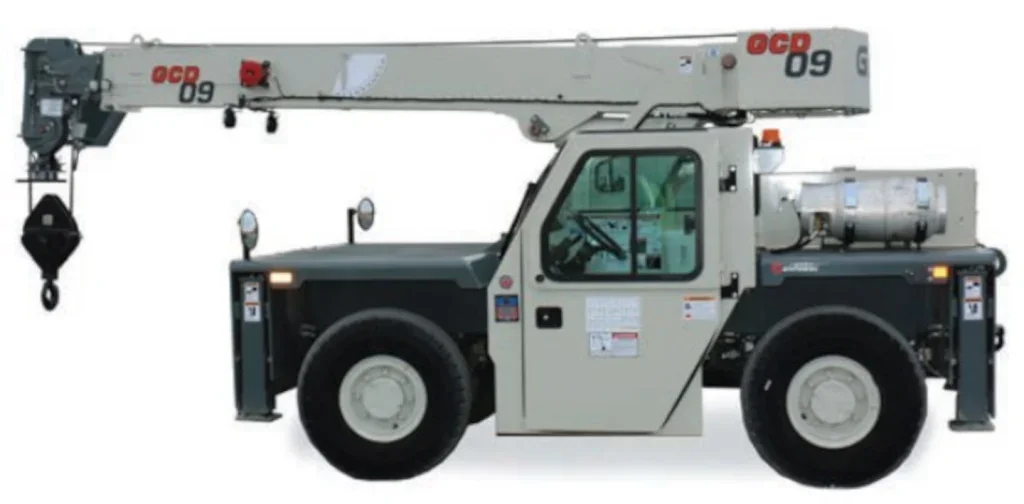
Quite why one market should embrace these machines with enthusiasm while others take no notice of them remains a mystery.
For US readers, there are two dominant makers of carry-decks. One of these is Broderson. Its carry-decks come in sizes ranging from the 5,000lb (2.5t) IC-20 to the ten-times-bigger 50,000lb (25t) IC-400. All are diesel-engined and operator ride-on. The small IC-20 has a deck area of 19 sq. ft (1.77 m2). On the IC-400 it is 74 sq. ft (6.94 m2). They are designed for indoor and outdoor use: auto manufacturing, petrochemical, pulp/paper mills, power plants, oil refineries, mining and construction are just some of the applications that Broderson suggest. They have outriggers for lifting; advanced load monitoring systems; antitwo- block systems; and proximity sensors as operator-assist systems.
Grove is the other major player here. Its carry deck offerings range from the 8.1 tonne (nine ton) GCD09 to the 22 tonne (25 ton) GDC25, with 13 ton and 18 ton models in between. The GCD09 has a 10m (33ft) three-section full-power main boom, multiple steering modes, and two-position outrigger. The deck carrying capacity is 6350kg (14000lb).
At the other end of the capacity spectrum the GCD25 boom is in four sections giving 21.6m (71ft) reach; the crane has four-wheel drive and all wheel steering. It also has a four-position pivoting boom head for low head room clearance; ‘out and down’ outriggers can be setup in several modes depending on jobsite requirements.
As we can see, from compact factory specialists to larger heavyduty articulated machines, the pick and carry sector is remarkably diverse and increasingly innovative.
Manufacturers around the globe continue to refine these versatile machines to meet the changing demands of industry. Despite distinct regional differences, one thing is clear; wherever they operate, these cranes remain indispensable tools combining strength, agility and adaptability in ways few other machines can match. Which crane is for you? Take your pick….
SARENS PAPUA NEW GUINEA TAKES DELIVERY OF 25 TONNE FRANNA MAC 25
As an example of the geographical spread of Terex’s Franna brand, back in January this year Sarens Papua New Guinea took delivery of a 25 tonne Mac 25 articulated pick and carry crane for use in the mining, oil and gas, construction, and industrial sectors. The Mac 25 is a tried and tested Franna design with an 18 metre four-section boom and a short three metre jib that, together, give a maximum tip height of 21.5 metres. Overall weight is just under 24 tonnes.
A key feature is the dynamic LMI (load moment indicator) system. It addresses the issue that is inherent to all articulated pick and carry designs – where cornering on a slope with a load can bring instability (see the main copy for more details.) Franna’s solution is not new – it was first released in 2013 – but its patented system underpins the electronic control and remains a pillar of safety.
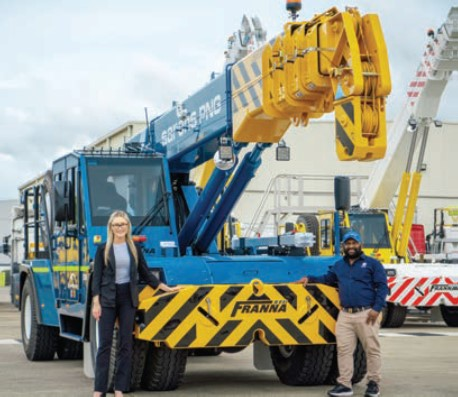
The system offers real-time calculation of rated capacity. It takes into account boom configuration as well as chassis articulation and pitch and roll to give continual assessment of structural limitations, forward stability, and side stability. Finer measurement of articulation pitch and roll angles now give increased resolution of rated capacity, allowing improved machine capability compared to previous generations of the system. On undulating terrain the rated capacity is updated continually, providing instantaneous information on the percentage utilisation of the machine in terms of the available capacity. When operating on a side slope operators are no longer required to manually calculate a reduction of rated capacity; the Franna Dynamic LMI does that for them.
A superlift upgrade is available on the MAC25-5 as an option. It works in tandem with the existing MAC25-5 counterweight, adding a low-slung additional counterweight piece to the rear of the machine to increase the rated capacity up to 30%.
STRONG PICK AND CARRY CAPABILITIES FROM SENNEBOGEN’S LATEST TELESCOPIC CRAWLER CRANE
Manufacturer Sennebogen’s new 6203 E telescopic crawler crane, launched at Bauma, is the largest and most powerful model in the series of ten telecrawlers that Sennebogen manufactures. It has a six-section pin boom that can be extended up to 56.4m. With the addition of a hydraulically adjustable fly jib this can be extended to 78m.
With short boom lengths, and at inclinations of up to four degrees, the crane is also powerful, says Sennebogen. This makes it particularly suitable for pick and carry operations, as well as tasks on uneven construction sites.
Pick and carry capabilities are further enhanced by the crane’s robust undercarriage and high load capacities in the inclined position, where it can travel with 100% of the specified load capacity on the hook.
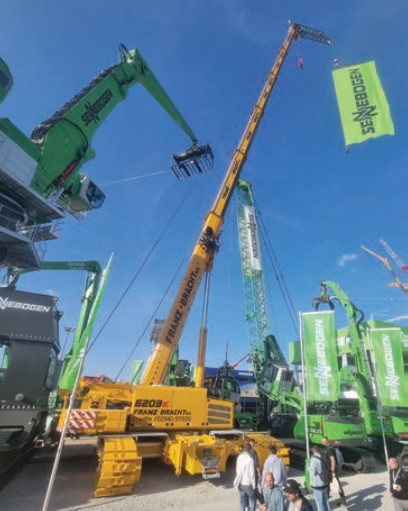
It can also slew the specified load capacities a full 360 degrees. The 1,000mm double grouser track shoes fitted as standard offer stability and minimise floor pressure, says Sennebogen. For more sensitive surfaces, durable polyamide plates can also be used as an option to prevent damage.
Overseeing these capabilities is a completely redesigned machine control system: the SLC – SENCON Load Control machine control system. To make operating the crane as comfortable as possible for the operator, a separate control system with its own screen has been integrated into the cab in accordance with automotive standards.
The new system is an addition to the existing SENCON (Sennebogen Control System) and provides all valuable data on the lifting process on a large display in addition to the load moment limitation. The extend modes can also be set here. There is also a floor pressure display calculated in real time.
The telescopic crawler undercarriage has a maximum track width of 6.0m, which can be reduced to up to 3.5m depending on the requirements of the construction site.
TADANO PRESENTS VALLA…
Following the acquisition of Manitex at the start of the year crane manufacturer Tadano has now taken over the sales, service and supply of spare parts for Valla pick and carry cranes in Germany, Austria and Switzerland. All cranes retain their former product nomenclature.
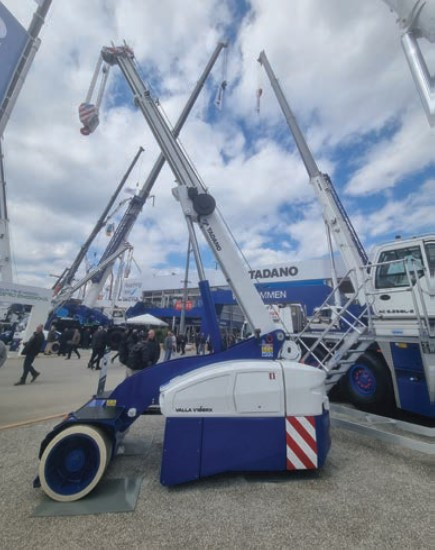
“The integration with Tadano enhances our ability to innovate and respond to customer needs faster, ensuring we remain at the forefront of lifting technology,” said Paolo Balugani, managing director of Valla.
At Bauma Tadano displayed three cranes from the Valla range: the V100RX, the 25E and the Valla V80R.


